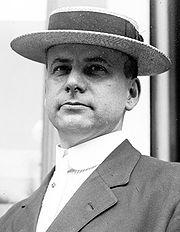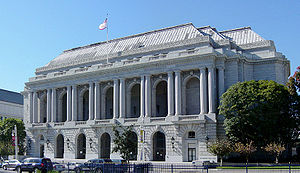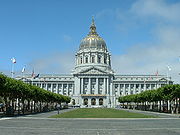
Arthur Brown Jr
Encyclopedia

Career
Brown was a member of Beta Theta Pi fraternity and graduated from the University of California, BerkeleyUniversity of California, Berkeley
The University of California, Berkeley , is a teaching and research university established in 1868 and located in Berkeley, California, USA...
in 1896, where he and his future partner, John Bakewell, Jr. (1872–1963), also a member of Beta Theta Pi, were both protégés of famed Bay Area architect Bernard Maybeck
Bernard Maybeck
Bernard Ralph Maybeck was a architect in the Arts and Crafts Movement of the early 20th century. He was a professor at University of California, Berkeley...
. Brown went to Paris
Paris
Paris is the capital and largest city in France, situated on the river Seine, in northern France, at the heart of the Île-de-France region...
and graduated from the École des Beaux-Arts
École des Beaux-Arts
École des Beaux-Arts refers to a number of influential art schools in France. The most famous is the École nationale supérieure des Beaux-Arts, now located on the left bank in Paris, across the Seine from the Louvre, in the 6th arrondissement. The school has a history spanning more than 350 years,...
in 1901, attending the atelier of Victor Laloux
Victor Laloux
Victor Alexandre Frederic Laloux was a French Beaux-Arts architect and teacher.- Life :Born in Tours, Laloux studied at the Paris École des Beaux-Arts atelier of Louis-Jules André, with his studies interrupted by the Franco-Prussian War, and was awarded the annual Prix de Rome in 1878...
, before returning to San Francisco to establish his practice with Bakewell in 1905.
Their first commissions included the interior of the City of Paris department store
City of Paris Dry Goods Co.
The City of Paris Dry Goods Company was one of San Francisco's most important department stores from 1850 to 1976, located diagonally opposite Union Square. During mid 20th century it opened a few branches in other cities of the Bay Area...
and the city hall for Berkeley, California
Berkeley, California
Berkeley is a city on the east shore of the San Francisco Bay in Northern California, United States. Its neighbors to the south are the cities of Oakland and Emeryville. To the north is the city of Albany and the unincorporated community of Kensington...
, before entering the competition for the 1915 San Francisco City Hall
San Francisco City Hall
San Francisco City Hall, re-opened in 1915, in its open space area in the city's Civic Center, is a Beaux-Arts monument to the City Beautiful movement that epitomized the high-minded American Renaissance of the 1880s to 1917. The structure's dome is the fifth largest in the world...
for which they are best known. Brown also designed the city's War Memorial Opera House and Veterans Building, the former in collaboration with G. Albert Lansburgh
G. Albert Lansburgh
Gustave Albert Lansburgh was an American architect, largely known for his work on luxury cinemas and theatres. He was the principal architect of theaters on the West Coast from 1900 - 1930.-Life and career:...
. Brown was meticulously trained in the rigorous Beaux-Arts tradition, and in the City Hall project his attention extended to the smallest details of light fixtures, floor patterning and doorknobs.

Arts and Crafts movement
Arts and Crafts was an international design philosophy that originated in England and flourished between 1860 and 1910 , continuing its influence until the 1930s...
style championed by Maybeck. Early among them were two redwood framed "double houses" for Stanford University in 1908, and the only fraternity house they designed from scratch, the Beta Chi Chapter House of Sigma Nu in 1910 (razed in 1991). They later designed additions to Ernest Coxhead's 1893 Beta Theta Pi house they had lived in as undergraduates, now a listed Berkeley landmark.
The firm went on to design a series of familiar San Francisco landmarks, and many buildings at Stanford University
Stanford University
The Leland Stanford Junior University, commonly referred to as Stanford University or Stanford, is a private research university on an campus located near Palo Alto, California. It is situated in the northwestern Santa Clara Valley on the San Francisco Peninsula, approximately northwest of San...
, before Brown dissolved the partnership in 1927. For contractual reasons many buildings at Stanford through the 1930s continued to be credited to both.
Most of Brown's later San Francisco works employed a stripped-down classicism. The poured-concrete Art Moderne
Art Deco
Art deco , or deco, is an eclectic artistic and design style that began in Paris in the 1920s and flourished internationally throughout the 1930s, into the World War II era. The style influenced all areas of design, including architecture and interior design, industrial design, fashion and...
Coit Tower
Coit Tower
Coit Tower is a tower in the Telegraph Hill neighborhood of San Francisco, California. The tower, in the city's Pioneer Park, was built in 1933 at the request of Lillie Hitchcock Coit to beautify the city of San Francisco; Coit bequeathed one-third of her estate to the city "to be expended in an...
(1932), that crowns Telegraph Hill
Telegraph Hill, San Francisco
Telegraph Hill refers to a neighborhood in San Francisco, California. It is one of San Francisco's 44 hills, and one of its original "Seven Hills."-Location:...
is an important Modernist landmark in the Bay Area. Coit Tower was the site of some of the first public works murals executed under the Public Works Administration
Works Progress Administration
The Works Progress Administration was the largest and most ambitious New Deal agency, employing millions of unskilled workers to carry out public works projects, including the construction of public buildings and roads, and operated large arts, drama, media, and literacy projects...
, later known as the WPA. "The primitive nature of Coit Tower would lend itself better to that sort of thing than other public buildings," was Arthur Brown's first reaction to the project. Diego Rivera
Diego Rivera
Diego María de la Concepción Juan Nepomuceno Estanislao de la Rivera y Barrientos Acosta y Rodríguez was a prominent Mexican painter born in Guanajuato, Guanajuato, an active communist, and husband of Frida Kahlo . His large wall works in fresco helped establish the Mexican Mural Movement in...
included Brown among the designers and craftsmen in his fresco
Fresco
Fresco is any of several related mural painting types, executed on plaster on walls or ceilings. The word fresco comes from the Greek word affresca which derives from the Latin word for "fresh". Frescoes first developed in the ancient world and continued to be popular through the Renaissance...
mural of The Making of a Fresco Showing the Building of a City (1931).

Interstate Commerce Commission
The Interstate Commerce Commission was a regulatory body in the United States created by the Interstate Commerce Act of 1887. The agency's original purpose was to regulate railroads to ensure fair rates, to eliminate rate discrimination, and to regulate other aspects of common carriers, including...
Building, its near-twin the Customs Department building, and the Andrew W. Mellon Auditorium
Andrew W. Mellon Auditorium
The Andrew W. Mellon Auditorium is a, 750-seat historic Neoclassical auditorium located at 1301 Constitution Avenue NW in Washington, D.C. The auditorium, which connects the two wings of the United States Environmental Protection Agency building, is owned by the U.S...
. All three form part of the Federal Triangle
Federal Triangle
The Federal Triangle is a triangular area in Washington, D.C. formed by 15th Street NW, Constitution Avenue NW, Pennsylvania Avenue NW, and E Street NW. Federal Triangle is occupied by 10 large city and federal office buildings, all of which are part of the Pennsylvania Avenue National Historic...
, the largest construction project undertaken by the US Federal government prior to The Pentagon
The Pentagon
The Pentagon is the headquarters of the United States Department of Defense, located in Arlington County, Virginia. As a symbol of the U.S. military, "the Pentagon" is often used metonymically to refer to the Department of Defense rather than the building itself.Designed by the American architect...
. Preliminary designs were begun in 1927, with construction in the Depression
Great Depression
The Great Depression was a severe worldwide economic depression in the decade preceding World War II. The timing of the Great Depression varied across nations, but in most countries it started in about 1929 and lasted until the late 1930s or early 1940s...
years between 1932 and 1934. The new buildings were to be designed to reflect the "dignity and power of the nation."
Brown's last works were primarily at UC Berkeley, where Brown served as campus planner and chief architect from 1936 to 1950. His principal buildings there include Sproul Hall, Valley Life Sciences Building, the Bancroft Library
Bancroft Library
The Bancroft Library is the primary special collections library of the University of California, Berkeley. It was acquired as a gift/purchase from its founder, Hubert Howe Bancroft, with the proviso that it retain the name Bancroft Library in perpetuity...
, and the Cyclotron Building, commissioned by Ernest Lawrence and J. Robert Oppenheimer.

American Institute of Architects
The American Institute of Architects is a professional organization for architects in the United States. Headquartered in Washington, D.C., the AIA offers education, government advocacy, community redevelopment, and public outreach to support the architecture profession and improve its public image...
in 1930. Among the draftsmen in his office was Clarence W. W. Mayhew
Clarence W. W. Mayhew
Clarence William Whitehead Mayhew was an American architect best known as a designer of contemporary residential structures in the San Francisco Bay Area...
.
Work
In San Francisco unless otherwise noted:- interior of City of Paris Dry Goods Co.City of Paris Dry Goods Co.The City of Paris Dry Goods Company was one of San Francisco's most important department stores from 1850 to 1976, located diagonally opposite Union Square. During mid 20th century it opened a few branches in other cities of the Bay Area...
, 1906–09 - City Hall, Berkeley, CaliforniaBerkeley, CaliforniaBerkeley is a city on the east shore of the San Francisco Bay in Northern California, United States. Its neighbors to the south are the cities of Oakland and Emeryville. To the north is the city of Albany and the unincorporated community of Kensington...
, 1908–09 - Horticulture Building, Panama-Pacific International ExpositionPanama-Pacific International Exposition (1915)The Panama-Pacific International Exposition was a world's fair held in San Francisco, California between February 20 and December 4 in 1915. Its ostensible purpose was to celebrate the completion of the Panama Canal, but it was widely seen in the city as an opportunity to showcase its recovery...
, 1915 - San Francisco City HallSan Francisco City HallSan Francisco City Hall, re-opened in 1915, in its open space area in the city's Civic Center, is a Beaux-Arts monument to the City Beautiful movement that epitomized the high-minded American Renaissance of the 1880s to 1917. The structure's dome is the fifth largest in the world...
, 1915 - Union Station (San Diego, California), 1915
- Valley Life Sciences BuildingUniversity of California Museum of PaleontologyThe University of California Museum of Paleontology is a paleontology museum located on the campus of the University of California, Berkeley....
, UC Berkeley, 1921 - Burnham Pavilion (Stanford University), 1921
- Toyon HallToyon HallToyon Hall is an all-sophomore dormitory at Stanford University. Its Romanesque and Mediterranean Revival Style residence halls originally housed 150 men, but today Toyon is a co-ed dorm housing 158 residents. Each of its three floors is co-ed, and most rooms are two-room doubles, although until...
, Stanford, 1923 - San Francisco Art InstituteSan Francisco Art InstituteSan Francisco Art Institute is a school of higher education in contemporary art with the main campus in the Russian Hill district of San Francisco, California. Its graduate center is in the Dogpatch neighborhood. The private, non-profit institution is accredited by WASC and is a member of the...
, 1925 - Temple Emanu-El, 1926
- Pacific Gas and Electric CompanyPacific Gas and Electric CompanyThe Pacific Gas and Electric Company , commonly known as PG&E, is the utility that provides natural gas and electricity to most of the northern two-thirds of California, from Bakersfield almost to the Oregon border...
Building, 1926 - Pasadena City HallPasadena City HallPasadena City Hall, completed in 1927, serves as the central location for city government in the City of Pasadena and it is a significant example of the City Beautiful movement of the 1920s.-History:...
, Pasadena, CaliforniaPasadena, CaliforniaPasadena is a city in Los Angeles County, California, United States. Although famous for hosting the annual Rose Bowl football game and Tournament of Roses Parade, Pasadena is the home to many scientific and cultural institutions, including the California Institute of Technology , the Jet...
, 1927 - Stanford Roble Gym, Stanford, 1931
- War Memorial Opera House, with G. Albert LansburghG. Albert LansburghGustave Albert Lansburgh was an American architect, largely known for his work on luxury cinemas and theatres. He was the principal architect of theaters on the West Coast from 1900 - 1930.-Life and career:...
, 1932 - Andrew W. Mellon AuditoriumAndrew W. Mellon AuditoriumThe Andrew W. Mellon Auditorium is a, 750-seat historic Neoclassical auditorium located at 1301 Constitution Avenue NW in Washington, D.C. The auditorium, which connects the two wings of the United States Environmental Protection Agency building, is owned by the U.S...
, Washington DC, 1935 - Stanford Memorial AuditoriumStanford Memorial AuditoriumMemorial Auditorium , dedicated in 1937, commemorates those students and faculty from Stanford who died in World War I. Designed by Bakewell and Brown, construction of the auditorium was funded primarily through student contributions...
, Stanford, 1937 - San Francisco Transbay TerminalSan Francisco Transbay TerminalSan Francisco Transbay Transit Terminal, or simply Transbay Terminal, was a transportation complex in San Francisco, California, USA, located roughly in the center of the rectangle bounded north–south by Mission Street and Howard Street, and east–west by Beale Street and 2nd Street...
, with Timothy L. PfluegerTimothy L. PfluegerTimothy Ludwig Pflueger was a prominent architect, interior designer and architectural lighting designer in the San Francisco Bay Area in the first half of the 20th century. Together with James R...
, 1939 - Hoover TowerHoover TowerHoover Tower is a structure on the campus of Stanford University in Stanford, California. The tower is part of the Hoover Institution, a research center founded by then-future U.S. president Herbert Hoover. Hoover Tower, inspired by the cathedral tower at Salamanca, was finished in 1941, the year...
, Stanford, 1941 - Bancroft LibraryBancroft LibraryThe Bancroft Library is the primary special collections library of the University of California, Berkeley. It was acquired as a gift/purchase from its founder, Hubert Howe Bancroft, with the proviso that it retain the name Bancroft Library in perpetuity...
, UC Berkeley, 1949
External links
- Online guide to the Arthur Brown, Jr. Papers, The Bancroft Library
- Diego Rivera's mural at the SFAI
- Coit tower

